This post was prompted by emails from groups seemingly (at the time, and now confirmed) associated with Asia Pulp and Paper (APP) that made dubious claims about the environmental, social, and economic performance of the pulp and paper industry in Indonesia. Evaluation of these claims has now raised serious questions on APP’s commitment to sustainability.

Tropical forest in Sumatra. Photo by Rhett A. Butler.
Over the past several years, Asia Pulp & Paper has engaged in a marketing campaign to represent its operations in Sumatra as socially and environmentally sustainable. APP and its agents maintain that industrial pulp and paper production — as practiced in Sumatra — does not result in deforestation, is carbon neutral, helps protect wildlife, and alleviates poverty [see APP documents]. While a series of analyses and reports have shown most of these assertions to be false, the final claim has largely not been contested. But does conversion of lowland rainforests for pulp and paper really alleviate poverty in Indonesia?
Environmental damage
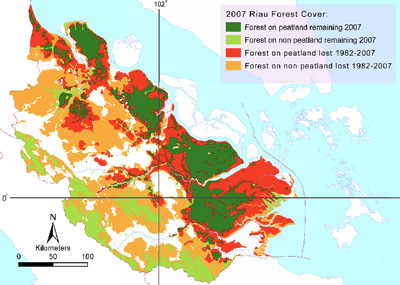 Natural forest loss in Riau on peat (red) and non peat soil (orange) between 2000 and 2007, and forest remaining on peat (dark green) and non peat (light green) in 2007. Map is from WWF-Indonesia’s Sumatra’s Forests, their Wildlife and the Climate Windows in Time: 1985, 1990, 2000 and 2009. Click on image to enlarge. |
A number of reports released over the past decade have documented the large-scale conversion of Sumatra’s lowland forests for pulp and paper production. Conversion has been driven by several actors, but two firms have accounted for the bulk of the activity: Asia Pacific Resources International Holdings (APRIL) and Asia Pulp & Paper (APP). Both companies have been called out by environmentalists as causing egregious environmental damage, including logging of rainforests, development of carbon-dense peatlands, and road-building in sensitive areas. In APP’s case, there have been allegations by Eyes on the Forest that it has engaged in open burning, in violation of Indonesian law and company policy, although it is unclear whether these fires were actually set by the plantation operator or communities surrounding the concession. In either case, such burning contributes to the choking haze that casts a pall over much of Southeast Asia on an increasingly frequent basis.
According to WWF-Indonesia, APP shoulders the brunt of the blame. Together with its suppliers, APP has cleared more than one million hectares of natural forests in Riau and Jambi provinces alone, making it responsible for more forest loss than any other company operating in Sumatra. Today, APP has at least 3.1 million tons of pulp capacity in Central Sumatra, while APRIL has roughly 3.2 million tons of production capacity. While both firms, which together account for about 80 percent of Indonesia’s total pulp production, have been feverishly expanding their plantations, both are still heavily dependent on deforestation: as of 2008 more than half their wood fiber came from natural forests. In 2010, the volume of timber sourced from the clearing of Riau’s natural forest reached 11.3 million cubic meters, up from 4.9 million cubic meters in 2009, according to Ministry of Forestry data. The sharp increase may be attributable to two factors: a 2008-2009 crackdown by provincial authorities on the use of mixed hardwoods going into pulp and paper mills and last year’s announcement of the country-wide moratorium on new concessions in natural forest areas and peatlands. The moratorium led companies to scramble to secure forest land before the two-year ban takes effect later this month.

A marketing problem
Laying waste to vast tracts of rainforest and peatlands that store large quantities of carbon and which are home to endangered species like Sumatran tigers, elephants, and orangutans, has given both APP and APRIL an image problem: they are now viewed as toxic brands by several major buyers in the United States and Western Europe. APP has especially suffered, losing Carrefour, Tesco, Kraft, Unisource, Staples, Walmart, Ricoh, Woolworths, Gucci, H&M, and Fuji Xerox, among others, since 2007. It has lost the right to use the FSC eco-certification label on its products. Meanwhile APRIL has been rebuked by the Rainforest Alliance’s SmartWood Program, which suspended the company’s FSC certification in April 2010. The defections have been painful for both firms, which have gone to great lengths to win back customers.
In APP’s case, instead of taking steps to meaningfully address concerns raised by former partners like WWF and the Rainforest Alliance, the paper giant has focused on marketing to rehabilitate its image. In the process, APP has employed ethically questionable tactics, including the use of front groups like the Tea Party-affiliated Consumer Alliance for Global Prosperity and the faux-humanitarian NGO World Growth International to launch public attacks on companies that have dropped its products and environmental organizations that have raised concerns about its environmental conduct. When auditors have presented results it didn’t like, APP has hired PR consultants — including ITS Global and Greenspirit — to put their own spin on the conclusions and produce favorable reports passed off as “independent audits.” While it remains unclear whether these measures are the brainchild of APP or the PR and lobbying firms it has retained in recent years — including Ogilvy & Mather, Weber Shandwick, Cohn & Wolfe, Clark & Weinstock — the messaging has been consistent: APP claims it is protecting the environment and alleviating poverty in Indonesia.
Helping the poor or helping themselves?
But does tearing down rainforests and draining peatlands for pulp and paper plantations really help lift the rural poor out of poverty?
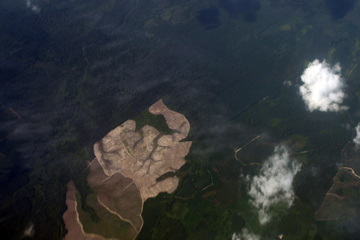 Riau Province, Sumatra. Photo by Rhett A. Butler |
APP’s own documents suggest otherwise. A 2005 document that looked at the potential for acquiring community land for pulp production found that net income from acacia pulp plantations was only 35,000 rupiah ($3.50) per month per hectare, making it nearly impossible to interest local communities, which earned 1.2 to 1.25 million rupiah ($120-125) per month on the same land from palm oil and rubber, respectively (returns from all three commodities, especially palm oil, are now higher). So despite claims of poverty alleviation by APP and the groups it bankrolls, there is a clear reason communities aren’t supporting pulp plantations: basic economics.
APP and APRIL like to tout the large numbers of workers they employ. What they don’t say is many of the jobs created in the pulp and paper sector are cyclical and many of the workers are migrants from other areas in Indonesia, not local community members. Hiring goes up when workers are needed to clear forests, dig canals, and plant and harvest acacia, but the bulk of these activities occur in years one and seven of the production cycle. The rest of the time only a small number of workers are needed due to the high capital-intensity of pulp and paper (new mills cost more than $1 billion). A 2005 study found that Riau’s pulp and paper industry generated 4.4 jobs in wood processing for every 10,000 cubic meters of roundwood consumed. By comparison, for the same volume of wood Riau’s plywood and wood working mills employed, on average, 126 workers, while licensed sawmills employed approximately 53 workers.
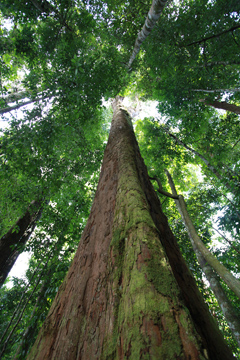 Giant Dipterocarp tree in Sumatra. Photo by Rhett A. Butler. |
The tradeoffs for these few jobs are substantial. Pulp and paper production ties up large areas of land that are traditionally used for subsistence activities, including small-scale logging, agroforestry, and collection of non-wood forest products (not to mention the ecosystem services afforded by forests like provision of water, flood control, and prevention of erosion). According to figures from APP, it creates roughly one job per 30 hectares of concession. (APP doesn’t specify any details of this employment and did not respond to mongabay.com’s request for clarification.) By comparison, average smallholder holdings in Indonesia range from 0.5 hectares per family for agroforestry to two hectares for oil palm. In short, when large areas of land are shifted from community control to the domain of a plantation company, many people are effectively locked out of livelihoods and employment per hectare drops significantly. In the case of pulp and paper, the overall exchange looks like a poor one for communities.
So if communities won’t buy into plantation schemes for economic reasons, what’s the alternative? Acquire large blocks of land from the government and import workers from other areas. Since 2004, APP-affiliated companies have acquired licenses to develop nearly 75,000 hectares of natural forest in the Bukit Tigapuluh landscape, an area that WWF rates as the highest conservation priority in all of Sumatra. To date, more than 60,000 hectares of this area have been cleared. APP also built a logging road that opened forest areas to illegal encroachment. Yet one of APP’s marketing claims is that its plantations reduce illegal encroachment by poor settlers.
In Indonesia’s best interest?
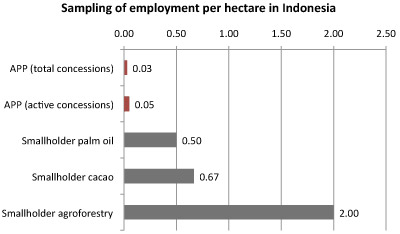
Sample of employment per hectare APP says it employs roughly 70,000 people and holds 2.4 million hectares of concessions, or about one person per 34 hectares of concession, in Indonesia (or 1 worker per 20 ha if the area APP has set aside for conservation is excluded). For comparison, average smallholder holdings for agroforestry in West Java (Ginoga 2004) were 0.5 ha, 2 ha oil palm Indonesia-wide (IPOC 2009), and cacao 0.5 to 1.5 ha (Yasa 2007) (A smallholder is counted as a single person). |
But is this a good investment for the people of Indonesia? Economic analysis of pulp and paper plantations in Sumatra raises serious questions. The 2005 Riau study estimated that each job created in the pulp and paper sector has required an investment of approximately $218,000. At the same time, APP received hundreds of millions of dollars in government subsidies despite defaulting on nearly $14 billion in debt in 2002-2003. Roughly half of the debt has now been restructured under favorable conditions.
If the financial benefits aren’t clear-cut, what about the other services, the pulp and paper industry says it delivers to local communities? APP maintains it is building schools and delivering health services. It may well be, but a field investigation in two villages around the Rimba Hutani Mas concession has not instilled much in the way of confidence in APP’s corporate social responsibility program. According to the field investigation, the main contribution towards education in communities around Muara Merang villages consisted of eight sacks of cement for a new school, 60 Sinar Mas-labeled books, and the sponsorship of Independence Day celebrations. Some villagers complained that while the local palm oil company provided a doctor at no cost, they had to pay to visit with the Rimba Hutani Mas physician. Free mass circumcision however was welcomed by the community when it was offered in 2007.
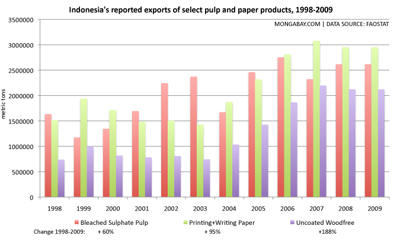 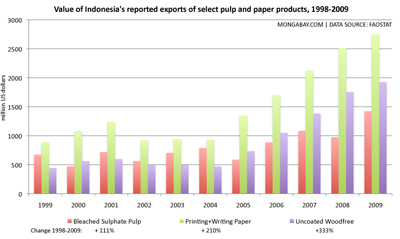 Export volume and value of selected Indonesian pulp and paper products. Click on images to enlarge. |
What about taxes? Is logging at least helping fill the coffers of the Indonesian treasury? At this point it is unclear. However three APP affiliates — PT Wirakarya Sakti, PT Rimba Hutani Mas, and PT Tebo Multi Agro — were named by the state audit agency (BPK) as delinquent in paying timber royalties or fines to the Jambi forestry service. Both APP and APRIL have extensive networks of affiliate companies outside Indonesia and are believed to be moving substantial portions of their profits offshore to avoid taxes. In fact APRIL’s oil palm subsidiary Asian Agri has been under investigation by Indonesia’s tax department for such activities.
But beyond tax fraud allegations, the pulp and paper industry has benefited from favorable tax incentives including accelerated depreciation for capital investments, which allows capital-intensive companies like APP and APRIL to minimize tax payments by continually expanding operations.
All this suggests that Indonesia should take a closer look at the benefits it receives from the pulp and paper industry before pushing for further expansion. The Indonesian government has already set ambitious growth targets for the industry—documents published in 2007 by the Ministry of Forestry call for increasing pulp capacity from 6.5 million metric tons per year in 2007 to 16 million metric tons by 2020 and paper-making capacity from 8.5 million tons in 2007 to 18.5 million tons by 2020. According to an analysis presented in a 2008 paper from the U.N. Food and Agriculture Organization, the planned expansion would require some 514,000 hectares of fast-growing plantations to be available annually for harvesting, which would require an overall net planted area of 3.6 million hectares and a gross plantation area of 4.7 million hectares. The target is certainly ambitious, but does it represent the best interests of Indonesians? Will converting an area of land 66 times the size of Singapore—much of it already used productively by communities—really help alleviate rural poverty in Indonesia? That’s a question Indonesians should be asking parties other than APRIL and APP to answer.
|
NOTES
“We would highlight the fact that the above work had a defined and limited scope and we would reiterate that the report should not be used without referring to the limitations of the scope,” the statement continued. “ERM has expressed concern to APP about the need to respond to the issues being raised and is currently engaging with APP in relation to APP’s use of ERM’s work and public statements made by APP in relation to the above.” WPP’s CEO, Sir Martin Sorrell, has made a video in support of Prince Charles’s Rainforest Project.
This article is available in Bahasa (Indonesian). |
Related articles
Will Indonesia’s big REDD rainforest deal work?
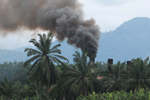
(12/28/2010) Flying in a plane over the Indonesian half of the island of New Guinea, rainforest stretches like a sea of green, broken only by rugged mountain ranges and winding rivers. The broccoli-like canopy shows little sign of human influence. But as you near Jayapura, the provincial capital of Papua, the tree cover becomes patchier—a sign of logging—and red scars from mining appear before giving way to the monotonous dark green of oil palm plantations and finally grasslands and urban areas. The scene is not unique to Indonesian New Guinea; it has been repeated across the world’s largest archipelago for decades, partly a consequence of agricultural expansion by small farmers, but increasingly a product of extractive industries, especially the logging, plantation, and mining sectors. Papua, in fact, is Indonesia’s last frontier and therefore represents two diverging options for the country’s development path: continued deforestation and degradation of forests under a business-as-usual approach or a shift toward a fundamentally different and unproven model based on greater transparency and careful stewardship of its forest resources.
Logging, palm oil giant hires U.S. ambassador as lobbyist
(12/09/2010) Sinar Mas Group, the sprawling Indonesian conglomerate that has interests in coal mining, logging and wood-pulp production, palm oil plantations, real estate, and other industries, has hired Cameron Hume, the former U.S. ambassador to Indonesia, as an adviser, according to Detik.com. Ambassador Hume stepped down from his post at the embassy in August.
Pulp plantations destroying Sumatra’s rainforests

(11/30/2010) Indonesia’s push to become the world’s largest supplier of palm oil and a major pulp and paper exporter has taken a heavy toll on the rainforests and peatlands of Sumatra, reveals a new assessment of the island’s forest cover by WWF. The assessment, based on analysis of satellite imagery, shows Sumatra has lost nearly half of its natural forest cover since 1985. The island’s forests were cleared and converted at a rate of 542,000 hectares, or 2.1 percent, per year. More than 80 percent of forest loss occurred in lowland areas, where the most biodiverse and carbon-dense ecosystems are found.
Indonesian logging company makes ‘deceptive’ claims on carbon conservation project
(11/24/2010) A major wood-pulp company is misleading the public over its commitment to reducing greenhouse gas emissions through a carbon conservation project in Sumatra, claims Greenomics, an Indonesian activist group.
Asia Pulp & Paper’s emissions from paper production 500 times higher than claimed
(11/04/2010) Asia Pulp & Paper is misrepresenting the greenhouse gas emissions generated through its paper production by several orders of magnitude claims a new analysis of its carbon footprint by the Rainforest Action Network (RAN) and the Japan Tropical Forest Action Network (JATAN).
Nobel Prize winner, anti-poverty group, scientists fire back at logging lobbyist
(11/01/2010) An industrial lobbyist is facing mounting criticism for his campaign to reduce social and environmental safeguards in Indonesia.
Scientists blast greenwashing by front groups
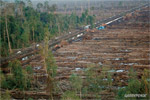
(10/27/2010) A group of prominent scientists has published an open letter challenging the objectivity of World Growth International, an NGO that claims to operate on behalf of the world’s poor, and its leader Alan Oxley, a former trade diplomat who also chairs ITS Global, a marketing firm. The letter, published online in several forums, slams World Growth and ITS Global as a front groups for forestry companies. The scientists note that while the groups have not disclosed their sources of funding, they assert ITS receives funding from Sinar Mas, an Indonesian conglomerate that controls Asia Pulp & Paper (APP), a forest products brand, and Sinar Mas Agro Resources & Technology, a palm oil firm, among other companies.














